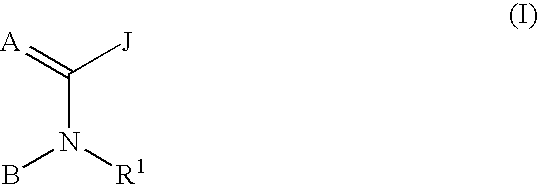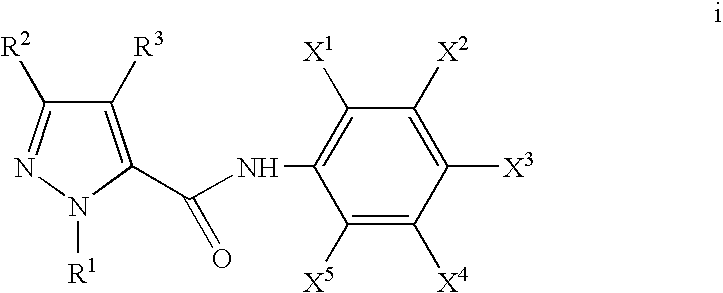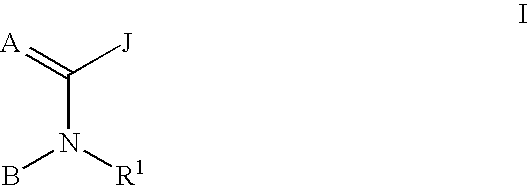Pyrazole and pyrrole carboxamide insecticides
a technology of pyrazole and pyrrole carboxamide, which is applied in the field of biocide, heterocyclic compound active ingredients, etc., can solve the problems of increasing consumer costs and significant productivity reduction
- Summary
- Abstract
- Description
- Claims
- Application Information
AI Technical Summary
Benefits of technology
Problems solved by technology
Method used
Image
Examples
example 1
Preparation of N-(2-chloro-6-methylphenyl)-1-(3-chloro-2-pyridinyl)-3-(trifluoromethyl)-1H-pyrazole-5-carboxamide
Step A: Preparation of 3-chloro-2-[3-(trifluoromethyl)-1H-pyrazol-1-yl]pyridine
[0092] To a mixture of 2,3-dichloropyridine (99.0 g, 0.67 mol) and 3-(trifluoromethyl)-pyrazole (83 g, 0.61 mol) in dry N,N-dimethylformamide (300 mL) was added potassium carbonate (166.0 g, 1.2 mol) and the reaction was then heated to 10-125° C. over 48 hours. The reaction was cooled to 100° C. and filtered through Celite® diatomaceous filter aid to remove solids. N,N-Dimethylformamide and excess dichloropyridine were removed by distillation at atmospheric pressure. Distillation of the product at reduced pressure (b.p. 139-141° C., 7 mm) afforded the title compound as a clear yellow oil (113.4 g).
[0093]1H NMR (CDCl3) δ 6.78 (s, 1H), 7.36 (t, 1H), 7.93 (d, 1H), 8.15 (s, 1H), 8.45 (d, 1H).
Step B: Preparation of 1-(3-chloro-2-pyridinyl)-3-(trifluoromethyl)-1H-pyrazole-5-carboxylic acid
[009...
example 2
Preparation of N-(2-bromo-4,6-difluorophenyl)-1-(3-chloro-2-pyridinyl)-3-bromo-1H-pyrazole-5-carboxamide
Step A: Preparation of 3-bromo-N,N-dimethyl-1H-pyrazole-1-sulfonamide
[0098] To a solution of N-dimethylsulfamoylpyrazole (44.0 g, 0.251 mol) in dry tetrahydrofuran (500 mL) at −78° C. was added dropwise a solution of n-butyllithium (2.5 M in hexane, 105.5 mL, 0.264 mol) while maintaining the temperature below 60° C. A thick solid formed during the addition. Upon completion of the addition the reaction mixture was maintained for an additional 15 minutes, after which time a solution of 1,2-dibromo-tetrachloroethane (90 g, 0.276 mol) in tetrahydrofuran (150 mL) was added dropwise while maintaining the temperature below −70° C. The reaction mixture turned a clear orange; stirring was continued for an additional 15 minutes. The −78° C. bath was removed and the reaction was quenched with water (600 mL). The reaction mixture was extracted with methylene chloride (4×), and the organic ...
example 3
Preparation of 1-(3-chloro-2-pyridinyl)-N-(2,4-dichlorophenyl)-3-(trifluoromethyl)-1H-pyrazole-5-carboxamide
[0108] To a solution of 1-(3-chloro-2-pyridinyl)-3-(trifluoromethyl)-1H-pyrazole-5-carboxylic acid (i.e. the product from Step B in Example 1) (6.0 g, 20.76 mmol) in 60 mL of methylene chloride was added oxalyl chloride (5.7 g, 44.88 mmol) followed by two drops of DMF. The mixture was stirred for two hours after which time the reaction was concentrated on a rotary evaporator at reduced pressure, taken up in chloroform, and concentrated a second time to remove residual oxalyl chloride. The resultant acid chloride was used directly in the next step.
[0109] To a solution of 2,4-dichloroaniline (382 mg, 2.35 mmol) in 3 mL of dry tetrahydrofuran was added a solution of the acid chloride (307 mg, 1.0 mmol) in 3 mL of chloroform, and the mixture was stirred at room temperature for four hours. After this time the reaction was partitioned between chloroform and saturated aqueous sodiu...
PUM
| Property | Measurement | Unit |
|---|---|---|
| Volume | aaaaa | aaaaa |
| Molar density | aaaaa | aaaaa |
| Fraction | aaaaa | aaaaa |
Abstract
Description
Claims
Application Information
 Login to View More
Login to View More - R&D
- Intellectual Property
- Life Sciences
- Materials
- Tech Scout
- Unparalleled Data Quality
- Higher Quality Content
- 60% Fewer Hallucinations
Browse by: Latest US Patents, China's latest patents, Technical Efficacy Thesaurus, Application Domain, Technology Topic, Popular Technical Reports.
© 2025 PatSnap. All rights reserved.Legal|Privacy policy|Modern Slavery Act Transparency Statement|Sitemap|About US| Contact US: help@patsnap.com



